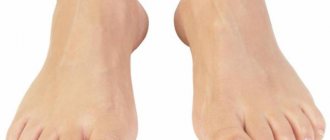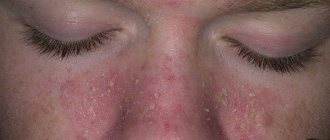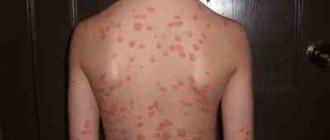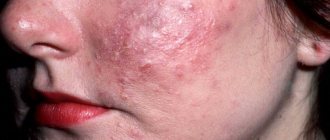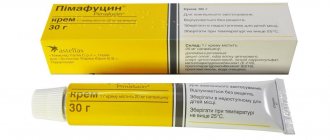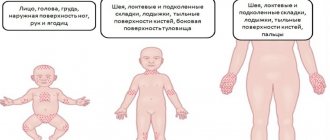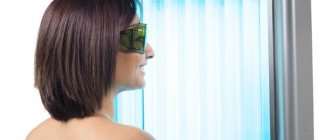Introduction
Dermatomycoses are diseases of the skin and nails caused by parasitic fungi..
Some types of this fungus only affect humans, while others can inhabit the body of a wider range of mammals.
However, some parasitic fungi are transmitted from animals to humans. Mycosis is an insidious disease that is difficult to treat and causes its carrier a lot of both physical and aesthetic inconvenience.
Routes of infection
Spores enter the body through contact with a sick person. People who work and live in the same premises are at risk.
Disputes may remain:
- on hygiene products;
- bed linen;
- furniture.
In 70% of cases, the pathology is transmitted after visiting baths, saunas, swimming pools, or beauty salons. If these establishments comply with SanPin standards, the risk of infection is reduced.
This information will be useful to you: “Tests for fungus: how to take them and how much they cost”
How does the virus get onto human skin?
Anyone can become infected with a fungal infection. It is enough just to be at the wrong time in a place favored by pathogenic organisms and touch (eat, drink) an infected object or touch a living creature carrying mycosis spores. People, animals, common areas, household items and even food and drinks - the source of infection can lurk in the most unexpected place.
People with weakened immune systems are especially susceptible to the pathogenic flora of mycoses. At the same time, patients with diabetes mellitus, human immunodeficiency virus, AIDS carriers, as well as patients undergoing chemotherapy and taking steroid treatment are at increased risk. People suffering from:
- Nervous system disorders.
- Severe stress, including due to overwork.
- Increased sweating.
- Diseases of the nervous system.
- Hypovitaminosis or vitamin deficiency.
- Allergies.
- Worm infestation.
- Injuries to the skin and nails.
- Physical exhaustion, including as a result of prolonged fasting.
- Disturbed metabolism.
- Hereditary predisposition to fungal diseases.
In addition, young children, people taking antibiotics, as well as people living in difficult living conditions or in regions with poor environmental conditions are at risk.
Once on the skin, fungal spores quickly penetrate the epidermis and begin to rapidly multiply, using the body of the infected object as a nutrient medium.
The main signs of infection in this case, as a rule, are itching, accompanied by peeling and redness, as well as roughening and scaly layering of the skin.
If the disease was not noticed in the early stages, in the absence of proper therapy, the symptoms are often added to the discharge of ichor from the affected areas, leading to suppuration.
If a patient has onychomycosis (fungal infection of the nail plate), the nails turn yellow, lose their integrity and eventually (in the absence of proper treatment) move away from the bed.
Mycosis that has settled on the scalp is indicated by uncharacteristic dry hair, accompanied by the appearance of dandruff and itching.
Symptoms
It is too early to give advice on treating foot fungus at home until the exact diagnosis is known. It can be determined by various symptoms, which can be open or hidden.
Hidden symptoms are more reminiscent of a cold, and they are: temperature, increased sweating of the whole body.
Main symptoms:
- Constantly wet feet.
- Unpleasant smell of rot and sweaty soles.
- Redness, peeling, itching and burning.
- Thickened pieces of skin that begin to fall off over time.
- The appearance of ulcerative formations with watery fluid.
- Cracks.
Known types of fungal infections proceed in the same way, without any significant deviations from the norm. But sometimes there are types of the virus that pass without smell or burning, but are definitely at risk.
Forms of the disease
Depending on the type of strain that affects the body, dermatomycosis can have a wide variety of manifestations.
Erythematous-squamous form
Infection with this type of mycosis is especially dangerous in hot weather, since under the influence of high temperatures and sweat secreted by the skin, pathogenic organisms of the strain develop rapidly, becoming chronic and causing all sorts of complications.
Erythematous squamous fungus can affect any part of the skin of the body. The infection process is necessarily accompanied by severe itching.
At the same time, it is extremely difficult to establish which strain caused the symptoms that arose at an early stage of the pathology, since many dermatomycosis have a similar clinical picture.
As the disease progresses, pronounced lesions appear on the skin, arranged in arcs, rings, garlands and other single or grouped rounded patterns.
At later stages of infection, an intermittent pathological ridge begins to form, which is a characteristic external sign of the erythematous-squamous form of the fungus.
Follicular nodular form
It is characterized by a more rapid and pronounced course. The first foci of fungus appear in the areas of the lower leg, buttocks, forearms and feet. Infected areas resemble erythema nodosum and quickly spread, affecting healthy skin around them. The lack of timely diagnosis and treatment of this form of dermatomycosis threatens the development of serious pathologies.
Preventive actions
Prevention of mycosis on the back looks like this:
- do not wear someone else’s clothes or use other people’s hygiene products;
- After taking a shower, wipe yourself dry - the fungus “loves” to develop under the conditions of the greenhouse effect, which is created against the background of a combination of moisture and heat;
- try not to visit public baths, saunas, swimming pools;
- choose the right underwear. Synthetic products should be abandoned in favor of cotton and linen;
- change bed linen promptly and keep clothes clean.
What do body spots, formations on the back, neck, abdomen look like (photo)?
Factors
Factors contributing to the development of mycoses in humans:
- diseases that reduce the protective functions of the immune system;
- pregnancy, puberty;
- HIV infection;
- poor personal hygiene;
- dysbiosis.
Skin fungus can occur on different surfaces, having different forms of infection, which depend on the type of fungus that causes the disease.
Of the hundreds of thousands of varieties of mycoses, fungi of the following genus mainly have a detrimental effect on humans:
- Candida;
- Trichophytum;
- Microsporum;
- Malassezia;
- Aspergillus;
- Phytosporum.
Some of them are saprophytes - components of the microflora of the human intestine, colon and vagina - these are Candida and Trichophytum.
Others are found in soil, dust, bird and animal excrement, soil, and enter the body with inhaled air, causing diseases:
- mucous membranes;
- respiratory tract;
- lungs;
- throat.
Signs and symptoms
The main signs of a fungal infection are itching and the appearance of rash-like or irritated patches of redness on the skin. Otherwise, the clinical picture of pathologies caused by skin fungi may vary depending on the specific strain.
Pityriasis versicolor
It is a superficial recurrent disease of the skin that is not inflammatory in nature. The causative agent is the yeast-like fungus Pityrosporum.
REFERENCE. People often call pityriasis versicolor “colored” for its ability to form rashes of a wide variety of shades on the affected areas of the skin. Other popular nicknames for this pathogen include “beach pityriasis” and “sun pityriasis.” These names are due to the most frequent occurrence of the disease during the hot season.
Men are more often affected by the pityriasis strain of mycosis than women . The main age group among patients with this diagnosis are people aged 15 to 40 years, while preschool children practically do not suffer from tinea versicolor.
An important feature of this type of pathogen is its low degree of contagiousness. In this case, an organism with a strong immune system can successfully fight the pathological strain.
The first stage of Pityrosporum reproduction occurs in the mouths of the sebaceous glands.
Further, the mouths of the hair follicles become infected, around which growing red spots form, merging with each other over time.
As a rule, these processes are observed on the chest, back, neck and scalp, but there are also cases of damage to other parts of the body.
As the disease progresses, the spots gradually change their shade from pink to red, then to burgundy and brown. In this case, there can be lesions of all shades on the body at the same time. The appearance of fused lesions is accompanied by intense peeling. Itching is practically absent.
Pityriasis versicolor can occur in 2 forms:
- Follicular (causes the formation of papules in the area of hair follicles).
- Inverted (progresses in skin folds).
If left untreated, the disease can progress for years, affecting more and more areas of healthy skin.
Damage to hair and nails
There are more than five thousand strains of fungus that can cause damage to nails and hair. All of them are extremely resistant to external influences, are difficult to treat and can remain viable for many years. The most common are the dermatomycetes Trichophyton, Epidermophyton and Microsporum.
Once on human skin, spores of Epidermophyton, Microsporum and Trichophyton usually affect only the nails and scalp.
Moreover, the chances of damage to these areas of the body rapidly increase in the presence of rubromycosis, trichophytosis and ringworm.
Athlete's nails are very contagious, can begin in people of any age and are expressed by yellowing of the nails, loss of the structure of the nail plate and its further falling away from the bed.
There are several most popular types of fungal hair diseases:
- Microsporia . With rare exceptions, it affects the hairy areas of the body and leads to focal or complete hair loss. The disease is accompanied by the appearance of red scaly inflammation on the skin, dryness and dandruff.
- Rubromycosis (rubrophytia) . An infectious fungal disease that can affect not only the scalp, but also the neck, face and torso.
- Trichophytosis . A fairly common type of lichen, caused by a parasitic fungus of the genus Trichophyton.
REFERENCE. The term lichen originated in the time of Hippocrates and refers to all fungal skin diseases accompanied by the appearance of a small scaly rash.
Mycosis of the feet
Caused by strains of Trichophyton interdigitale and Trichophyton rubrum. Often found among a wide range of age categories.
The cause of foot fungus is often simple neglect of hygiene rules , wearing uncomfortable shoes, as well as contact with the direct carrier of the strain or his personal items (shoes, socks, slippers, etc.).
Trichophyton interdigitale affects the skin on a person’s legs, while Trichophyton rubrum can cause inflammatory processes in any part of the body (including hair or nails).
Rubromycosis
Rubromycosis is a dermatomycosis that prefers smooth areas of skin for the propagation of its colonies. It is caused by the fungus Trichophyton rubrum and affects the tissues of the extremities, inguinal-femoral folds, as well as areas of the body with secondary hair growth.
Trichophyton rubrum spores can lie dormant for a long time after infection. After some time, the disease manifests itself. As a rule, the first rashes are found in the interdigital folds of the feet, moving to the sides of the feet, and then to the sole.
The course of rubromycosis is associated with the appearance of tiny scales (floury desquamation), as well as symptoms of dryness, hyperemia and hyperkeratosis.
The main signs of mycosis of the back
Diagnosing the manifestation of a skin lesion is quite simple, the main thing is to know what the fungus looks like on the back. Usually this is a change in the color of the epidermis, the appearance of spots of different sizes that differ in color. If you have the slightest suspicion, you can look at a photo of a fungus on your back on the Internet to have an accurate idea of what this disease looks like.
Symptoms of skin fungus:
- The appearance of spots. Most often white, but can also be red or brown;
- Some areas of the epidermis on the back become rough to the touch. These areas feel dry and itchy;
- The skin looks thin and dry, and the slightest touch leaves noticeable scratches. Sometimes the skin begins to crack;
- Constant discomfort in the back area, which intensifies when exposed to heat and moisture.
It should be understood that without proper therapy, the symptoms will not only not disappear, but will also worsen. Mycosis in the early stages can be cured quite easily; in more advanced conditions, the patient can be put into remission. But with the next set of unfavorable circumstances, the disease may again remind itself.
Read also: Diseases of the back and spine: main symptoms, causes.
Diagnostics
Most skin fungal diseases are characterized by rapid progression. That is why it is extremely important to notice the pathology in time, correctly identify the strain that caused it and prescribe effective treatment even before the onset of chronic complications.
It is necessary to understand that many types of dermatomycosis can occur not only on the external integument of the body, but also in the internal organs, causing difficult to correct consequences for the body.
You can anticipate the progression of the disease by promptly contacting a qualified dermatologist. The specialist will examine scrapings taken from the affected areas of the body and accurately determine the causative strain. Only after identifying the fungus will it be possible to prescribe effective therapy to completely get rid of not only the symptoms of the pathology, but also its causative agent.
How can you help?
The doctor begins to treat fungus on the back only after making a diagnosis.
The following activities are carried out:
- iodine test;
- visual inspection;
- examination under Wood's lamp;
- taking a scraping.
Complex therapy is used, which is based on the combination of several techniques. The basis of treatment is the use of drugs - only with their help can it be possible to destroy mycosis, which penetrates deep into the structure of epidermal cells.
You may find this method useful: “These tablets will cure fungus! (Top 8 effective drugs)"
Treatment of the disease
Most fungal diseases occur against the background of an immune decline in the body. This fact seriously complicates the treatment of dermatomycosis.
To successfully combat the fungus, it is customary to use medications that have a systemic effect.
In the most difficult cases, pathogenetic therapy comes to the rescue. Moreover, depending on the results of preliminary diagnosis, medical methods of combating the fungal strain may vary significantly.
The most effective results in the fight against dermatomycosis can be achieved by a set of measures, including:
- The use of antifungal agents, both local and systemic.
- Therapeutic treatment at the pathogenetic level.
- Thorough treatment of the patient’s home and personal belongings.
- Regular adherence to personal hygiene rules.
Local treatment
Getting rid of the external manifestations of dermatomycosis diseases is an easily accomplished task. For this purpose, dermatologists have an extensive list of effective topical remedies.
Among modern medicines for fungus there are ointments, sprays, drops, lotions, powders and other preparations convenient for self-application. All of them are effective, but can only relieve the patient from the external manifestations of the disease. Only longer and more complex therapy can destroy the strain of fungus that has settled in the body.
Depending on the diagnosed pathology, the fungus is treated with the following types of medications for topical use:
- Antimycotic drugs containing antibiotics, as well as corticosteroids (for example, Mikozolon, Lotriderm or Triderm). They are used in cases of significant damage to the skin and their swelling, as well as in the event of secondary infection.
- Azoles (for example, Clotrimazole, fluconazole, etc.) and drugs of the allylamine group (Lamisil, etc.).
Treatment with systemic antifungal drugs
If a moderate or severe stage of dermatomycosis is diagnosed, the patient is prescribed treatment with systemic drugs.
Typically, medications used in therapy are introduced into the body through pills or injections.
At the same time, throughout the treatment, it is extremely important for the patient to be regularly examined by the attending physician.
Modern dermatology uses two main groups of drugs to treat skin mycoses:
- Allylamines (for example, Intraconazole, Naftifine, etc.).
- Azoles (Fluconazole, Intraconazole).
The prescription of the drug, as well as its administration, must be carried out under the supervision of a qualified dermatologist.
Pathogenetic therapy
If a pathological course of a fungal disease is detected, the doctor prescribes drugs with pathogenetic effects. The main goal of such therapy is to restore the protective forces lost during the course of the disease, body functions, as well as normalize metabolism and immune reactivity.
Pathogenetic therapy allows you to minimize the risk of developing chronic forms of fungal disease and reduce the likelihood of side effects.
Reasons for treatment failure
During treatment for dermatomycosis, it is extremely important to strictly follow all recommendations given by your doctor. As a rule, the reason for the ineffectiveness of the therapy is the patient himself, who interrupted the course ahead of time or did not comply with the frequency of taking medications.
Another reason for re-infection is often self-medication (including traditional methods). An infected person cannot confidently determine the strain of the fungus, much less choose an effective and safe remedy to get rid of it. Therefore, the best way to end the infection once and for all is to visit a dermatologist.
Treatment of foot fungus with traditional drugs
Medicines for treating fungus at home often have a positive effect and completely destroy the virus.
But, you should be extremely careful in choosing drugs that are suitable for your body. If you have certain allergic reactions, you should tell your doctor or pharmacist right away.
For a correct diagnosis, it is necessary to undergo a number of important tests:
- Scraping the skin or part of the nail that is affected by fungal growth.
- DNA macromolecule analysis.
- Examination by a dermatologist.
- Examination of material under a microscope.
Medications:
Products containing azole: miconazole, clotrimazole, fluconazole. Suitable only for certain types of fungi.
Products with allylamine derivatives: terbinafine, naftifine. They are antimycotic drugs.
Keratolytics and corticosteroids - which have a combined effect, relieve inflammation and restore skin tissue.
ethnoscience
Folk remedies can effectively help get rid of the external manifestations of mycosis, but are ineffective in combating its root causes.
Thus, self-prepared medications can only support the therapy prescribed by the doctor, but cannot replace it.
Modern traditional medicine successfully uses the following remedies to treat skin and nail fungus:
- Garlic . Chopped garlic is mixed with butter in a 1 to 1 ratio and applied to infected areas of the body.
- Soda . For large-scale fungal infections, take a 20-minute bath a day with half a glass of baking soda.
- Mint . Lotions are made from mint and table salt and applied for 1 hour once a day until the external manifestations of mycosis are eliminated.
- Horsetail . 2 tablespoons of horsetail are brewed with a glass of boiling water. The infusion is used to wipe the affected areas.
- Onion . The juice of the rhizome of this plant is used in its pure form to wipe fungus-infected skin.
- Lilac . An alcoholic tincture from the flowers of this plant is used for medicinal rubdowns.
- Propolis . An alcohol solution of propolis is used to treat affected areas.
- Celandine . The juice of this plant is used to cauterize pathological formations on the skin caused by a fungus.
- Coffee . The freshly brewed grain drink is cooled and used to prepare baths and compresses.
- Kalanchoe . The juice of the leaves of the plant is used to make medicinal lotions.
Types of fungus
Fungal infection depends on many factors and causes, so it is difficult to cure the disease unless dangerous pathogens are eliminated from life. To quickly and easily cure foot fungus, you should first understand the form of mycosis.
Types of foot fungus:
- Candida species - appears and multiplies due to reduced immunity, most often develops in females.
- Athlete's foot - on the contrary, frequent victims of this fungus are men due to their increased sweating.
- Trichophytosis species is the most common species, which is transmitted by contact with an infected person.
Stages of disease development
Once on the skin, fungal spores begin to develop, going through several main stages :
- Incubation period.
- Growth and reproduction of colonies.
- Infection subsides.
At the moment the pathological flora is introduced onto the human dermis, his immunity can work without failures, then the spores will remain in the incubation period. This stage can last weeks, months, and sometimes even years.
But as soon as the victim’s body’s defenses weaken, mycotic particles wake up and begin to rapidly infect healthy skin cells, using it as a nutrient medium.
REFERENCE. A person infected with spores of a parasitic fungus may not be aware of it for years, being a source of infection for everyone around him.
About mycoses
Mycoses are fungal diseases caused by pathogenic fungi; they affect:
- surface of the skin, its deep layers;
- joints;
- soft tissues;
- internal organs;
- mucous membranes;
- bone mass.
Being part of the human flora, their reproduction is controlled by the immune system, but as soon as the protective functions reduce the effectiveness of their activities, the growth of fungal spores increases significantly, which leads to the development of various mycoses.
Prevention
Anyone can become infected with a fungus by picking up its spores from household items, surfaces in public places, animals, and even drinks or food. Where does this harmful fungus come from, and is it possible to predict in advance how it will get on the skin?
Fungus lives everywhere . That is why the best way to protect yourself from this insidious infection is to be sensitive to your own immunity and regularly follow all the rules of personal hygiene. It is also necessary to carefully monitor the living conditions in your own home, carrying out wet cleaning and sanitizing of personal use areas, and treating shoes.
Causes of foot fungus
The viral fungus is transmitted instantly, but it is extremely difficult to get rid of it. The pathology of infection carries with it a danger to the sick person, although not significant.
This is why many people like to self-medicate by purchasing medications that may not be suitable for them. Often such treatment methods lead to deterioration of the skin of the legs.
In addition, there are many reasons for the appearance of mycosis of the feet and toes. Knowing the cause, it is important to start treatment on time. If this or that type of fungus has haunted you and your family all your life, and the idea about it has long been correct, then you can purchase medications without a prescription. In this case, it is important to study the instructions for proper treatment of foot fungus at home.
Main reasons:
- Increased sweating.
- Tight shoes or minor injuries.
- Using someone else's personal belongings: towel, soap, washcloth, shoes, clothes, razor, and so on.
- Neglecting safety precautions and walking barefoot in public recreation areas.
- A weakened immune system and taking antibiotics or hormonal drugs.
Causes of nail deformation
Molds, yeast-like fungi and dermatophyte fungi cause infectious diseases of the nails (onychomycosis), which manifest themselves with similar symptoms.
All types of nail fungi on the toes or hands deform the nail plate, change its transparency, shine, color; this variety can be seen in the presented photos.
Nail changes occur not only with onychomycosis, but also with injuries, chronic paronychia (inflammation of the nail fold), psoriasis, hand eczema, and dermatitis. Before making a conclusion about a fungal infection, you need to consider all possible options.
Pityriasis versicolor
The disease occurs in young and middle-aged people. The causative agent of the infection is the fungus Pityrosporum. Fungi live on smooth skin and head. The main reason for the activation of the fungus is a change in the composition of sweat and increased sweating.
The chemical characteristics of the secreted substance change during diseases:
- stomach;
- intestines;
- endocrine system;
- immunodeficiency.
The spots are localized in the abdomen and chest. Less commonly, the fungus affects the groin area, arms, legs, and head.
What is pityriasis versicolor (lichen versicolor)? How to distinguish it from other types of mycosis?
- Pink spots with a slight degree of dryness and flaking.
- As the lesions heal, they change color. First to a light brown shade, then to a dark brown color.
- The lesions may merge into one spot.
- Irregular shape of spots.
- The color of the spots depends on the presence of a tan. On dark skin the rash is darker than on light skin.
- Itching of the affected areas is practically absent.
- White spots appear when exposed to ultraviolet light.
Tinea versicolor is not transmitted from a sick person to a healthy person.
Symptoms of mycosis of smooth skin
Symptoms of mycosis of smooth skin depend on the type of pathogen. However, there are also common symptoms that are characteristic of different forms of the disease. These are itching, peeling of the skin, peeling off pieces of skin, diaper rash, redness or change in skin color (in the form of spots), and the formation of papules. Sometimes a rash and diaper rash appear. The areas affected by the fungus can be located in different parts of the body, although there is a misconception that only the feet can become infected. It is not always possible to distinguish a fungal skin infection from pyoderma (bacterial infection). However, both diseases can often be combined.
Seborrheic dermatitis
The scalp is affected by a yeast-like fungus Pityrosporum ovale. The body is parasitized by the fungus Pityrosporum orbiculare. Activation occurs in places where sebum accumulates due to excessive work of the sebaceous glands.
Fungal reproduction is caused by:
- hormonal imbalance;
- autoimmune diseases;
- neurogenic factors.
Sometimes foci of infection are localized at the border between the growth of eyebrows and eyelashes. As a result, the vegetation thins and breaks down. In some cases, the fungus is activated in the nasolabial folds, behind the ears.
Features of seborrhea:
- inflamed spots;
- slight peeling;
- moderate or intense itching.

